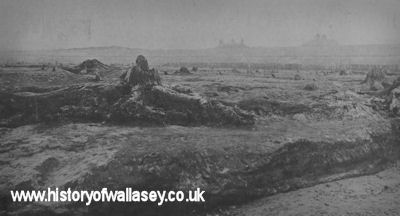Leasowe’s submerged forest was the mystery no-one ever really solved. Historians haggled about it. The experts were divided. Those with imagination wove stories around it. The curious came in hundreds to look at the last of it. It was something strange and dark. A puzzle on the local seashore. The stuff of lore and legend.
The last of if disappeared over 80 years ago. The sea that had swamped it finally washed it away.
The sand at Leasowe was broken by a thick stratum of peat. A collection of tree stumps, fallen trunks, ferns, lichens and roots was embedded in a mass of turf bog.
Some of the old tree trunks stood there three or four feet high. Fallen trunks and large branches lay partly buried.
It was established that the bog was part of a stratum which extended far beneath the land.
The part visible at low tide was a small portion which had been exposed through the action of the tide.
 |
Taken in the 1930s, the photograph shows part of the 'submerged forest' along the Leasowe shore. |
A visitor to Wirral in 1622 wrote:
“In these mosses are fir trees found under the ground, in some places six feet deep or more, and in others not one foot...”
The trees, he noted, were of surprising length, and straight, having “certain branches, like boughs, and roots at one end as if they had been blown down by winds...”
The chronicler went on:
“No man can tell that ever such trees did grow there nor yet how they should come thither.
“Some are of the opinion that they have lain there ever since Noah’s flood...
“Parts of the trees were in the old days cut away cut away by local residents, shaped into short pieces, and used instead of candles. They were said to give a very good light...”
In 1828 a visitor described the submerged forest in these words:
“The beach at about half-tide level presents a curious and highly interesting spectacle of the remains of a submerged forest.
“These numerous roots of trees which have not been washed away by the sea, or carried off by the neighbouring inhabitants for firewood, are in a very decayed state.
“The trees seem to have been cut off about two feet from the ground after the usual practice in felling timber.
“The roots are seen ramifying from their respective stumps in all directions and dipping towards the clay sub-soil...”
The trees, which were largest in the direction of Meols and smaller towards Leasowe, were chiefly oak and fir, with some alder, birch and elm.
At Leasowe Castle the library was constructed of timber from the old forest. Local residents made good use of it for carving and making furniture.
During the 19th Century an enormous number of relics were found dating from pre-Roman times to the 1700’s. Mostly small in size, the objects were of gold, silver, lead, bronze, glass, flint, and amber. There were ornaments and jewellery, arrows, knives, keys, spoons, and nails.
One reference book suggests that the site was that of an ancient settlement. There are lots of theories, but not one expert appears to have agreed with another. Conjecture ran wild.
Between 1922 and 1935 a series of photographs was taken of the forest by George Ellison. The last of the views showed the remnants of the peat bed but no trace of the forest was visible.
Still to be seen in Leasowe Castle is an alabaster bas-relief on a landing with the following painted above it:
“These remains of a forest were found under the peat soil upon this shore and seem to verify the local adage ‘From Berkinhevin unto Hilbre a squirrel might leap from tree to tree’.”
It is known that there has been considerable erosion of the Wirral coastline for hundreds of years. Villages now lie buried out to sea.
The old forest, the sightseer attraction at Leasowe, was probably the last remainder of a vast forest which once covered the Wirral.
It was a link with the days when Leasowe was thickly wooded and a popular place for hunting among the gentry.
The forest was there when neighbouring Moreton was a tiny hamlet with a little chapel on one side of it and a maypole on the other.
It was the forest claimed by the sea. Nothing remains if it now.
Featured sites
- Non Gamstop Casinos
- Casino Not On Gamstop
- UK Casinos Not On Gamstop
- Non Gamstop Casinos UK
- Sites Not On Gamstop
- Sites Not On Gamstop
- Casinos Not On Gamstop
- Casinos Not On Gamstop
- Casinos Not On Gamstop
- Non Gamstop Casino UK
- Casinos Not On Gamstop
- Non Gamstop Casino
- UK Online Casinos Not On Gamstop
- UK Online Casinos Not On Gamstop
- Non Gamstop Casinos
- Casino Sites Not On Gamstop
- Casinos Not On Gamstop
- Casinos Not On Gamstop
- Best Betting Sites
- Casinos Not On Gamstop
- Gambling Sites Not On Gamstop
- Betting Sites That Are Not On Gamstop
- Non Gamstop Casinos UK
- UK Online Casinos Not On Gamstop